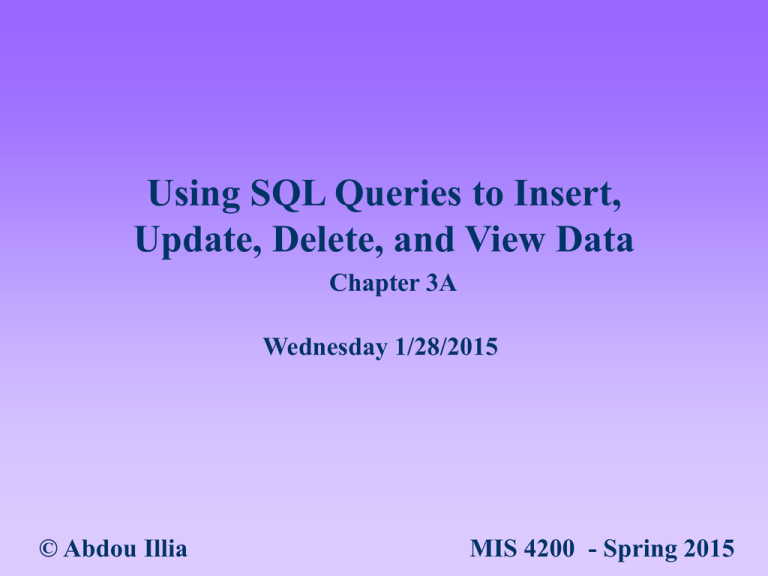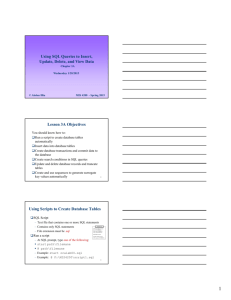Using SQL Queries to Insert, Update, Delete and View Data
advertisement

Using SQL Queries to Insert,
Update, Delete, and View Data
Chapter 3A
Wednesday 1/28/2015
© Abdou Illia
MIS 4200 - Spring 2015
Lesson 3A Objectives
You should know how to:
Run a script to create database tables
automatically
Insert data into database tables
Create database transactions and commit data to
the database
Create search conditions in SQL queries
Update and delete database records and truncate
tables
Create and use sequences to generate surrogate
key values automatically
2
Using Scripts to Create Database Tables
SQL Script
– Text file that contains one or more SQL statements
– Contains only SQL statements
– File extension must be .sql
Script1.sql
CREATE TABLE location
(loc_id NUMBER(5),
bldg_code NUMBER(3)
room VARCHAR2(20);
Run a script
–
–
–
DESCRIBE location
ALTER TABLE location
ADD (capacity NUMBER(5);
At SQL prompt, type one of the following:
start path\filemane
@ path\filemane
Example: start oralab00.sql
Example: @ F:\MIS4200\script1.sql
3
Using the INSERT Command
Basic syntax for inserting data into every column:
INSERT INTO tablename
VALUES (column1_value, column2_value, … );
–
–
–
–
Must list values in same order as in CREATE TABLE
If a data value is unknown, must type NULL
If character data, must use single quotation marks
Value in quotations is case sensitive
Basic syntax for inserting into selected columns
INSERT INTO tablename (columnname1, columnname2, …)
VALUES (column1_value, column2_value, … );
Example
INSERT INTO student
VALUES (‘JO100’, ‘Jones’, ‘Tammy’, ‘R’, ‘1817 Eagleridge Circle’, ‘Tallahassee’, ‘FL’, ‘32811’, ‘7155559876’, ‘SR’,
TO_DATE(‘07/14/1984’ ,‘MM/DD/YYYY’), ‘8891’, 1, TO_YMINTERVAL(‘3-2’));
4
Note: To specify 454 St. John’s Place, must type '454 St. John ''s Place'
Question: If you couldn’t remember the columns’ order for the table you want to insert data in, what command can you use in SQL Plus to verify?
Using the INSERT Command (cont.)
Ensure all foreign keys that new row references have
already been added to database.
Cannot insert a foreign key value unless the corresponding
primary key is in the primary table.
5
Format Models
With the $9999.99 mask, 1250.75 appears as $1250.75
Also called format mask
Used to specify different output format from default
For NUMBER data types, 9 represents digit
For DATE/TIMESTAMP data types
– Choose formats for year day, date, etc.
6
With the $9999.99 mask, how will appear 1500? 2340.1?
Inserting Date and Interval Values
Inserting values into DATE columns
– Use TO_DATE function to convert string to DATE
– Syntax:
TO_DATE('date_string', 'date_format_model')
– Example:
TO_DATE ('08/24/2010', 'MM/DD/YYYY’)
Inserting values into INTERVAL columns
– Syntax
• TO_YMINTERVAL('years-months')
• TO_DSINTERVAL('days HH:MI:SS.99')
Example
INSERT INTO student
VALUES (‘JO100’, ‘Jones’, ‘Tammy’, ‘R’, ‘1817 Eagleridge Circle’, ‘Tallahassee’, ‘FL’, ‘32811’,
‘7155559876’, ‘SR’, TO_DATE(‘07/14/1984’ ,‘MM/DD/YYYY’), ‘8891’, 1, TO_YMINTERVAL(‘3-2’));
7
Inserting LOB Column Locators
Oracle stores LOB data in separate (alternate)
physical location from other types of data
LOB locator needs to be created to
– Hold information that identifies LOB data type, and
– Point to alternate memory location
Syntax for creating blob locator
EMPTY_BLOB()
INSERT INTO faculty (f_id, f_last, f_first, f_image)
VALUES (2, ‘Zhulin’, ‘Mark’, EMPTY_BLOB());
8
Creating Transactions and Committing
New Data
Transaction
– Represents logical unit of work (or action queries)
– All of action queries must succeed or no transaction can
succeed
When a problem occurs and prevents some queries in a
transaction to succeed, Oracle allows you rollback
Rollback
– Discard changes in transaction using ROLLBACK
Commit
– Save changes in transaction using COMMIT
9
Creating Transactions & Committing Data (cont)
Purpose of transaction processing
– Enable users to see consistent view of database
– Preventing users from viewing or updating data that are
part of a pending (uncommitted) transaction
New transaction begins when SQL*Plus started and
command executed
Transaction ends when current transaction committed
ROLLBACK command restores database to point
before last commit
10
Rollback and Savepoints
Savepoints are used to rollback transactions to a
certain point.
11
Creating Search Conditions in SQL
Queries
Search condition
– Expression that seeks to match specific table rows
Syntax
WHERE columnname comparison_operator search_expression
Example:
DELETE FROM student WHERE s_id = ‘JO100’
12
Defining Search Expressions
NUMBER example: WHERE f_id = 1
Character data example: WHERE s_class = 'SR'
DATE example
WHERE s_dob = TO_DATE('01/01/1980', ‘MM/DD/YYYY')
Creating Complex Search Conditions
Complex search condition combines multiple search
conditions using logical operators
AND logical operator: True if both conditions true
OR logical operator: True if one condition true
NOT logical operator: Matches opposite of search
condition
Example
WHERE bldg_code = ‘CR’ AND capacity > 50
13
Updating Table Rows
UPDATE action query syntax
UPDATE tablename
SET column1 = new_value1, column2 = new_value2, …
WHERE search condition;
Question: In a previous class session, we learned about the ALTER TABLE command. What is the
difference between the ALTER TABLE and the UPDATE commands?
14
Deleting Table Rows
The DELETE action query removes specific rows
Syntax:
DELETE FROM tablename
WHERE search condition;
The TRUNCATE action query removes all rows
– TRUNCATE TABLE tablename;
Cannot truncate table with foreign key constraints
– Must disable constraints, first, using
ALTER TABLE tablename
DISABLE CONSTRAINT constraint_name;
15
Deleting Table Rows (continued)
Child row: a row containing a value as foreign key
– Cannot delete row if it has child row. In other words,
you cannot delete a “parent” row …
• Unless you, first, delete row in which foreign key value
exists
– Cannot delete LOCATION row for loc_id = 9 unless
you delete FACULTY row for f_id = 1
FACULTY
Child row
F_ID
F_LAST
F_FIRST
F_MI
LOC_ID
1
Marx
Teresa
I
9
LOC_ID
BLDG_CODE
ROOM
CAPACITY
9
BUS
424
1
LOCATION
“Parent” row
16
Creating New Sequences
A sequence is a series of number like 1, 2, 3, …
A sequence can be created as a database object
CREATE SEQUENCE is used to create a sequence
– CREATE SEQUENCE is a DDL command
– No need to issue COMMIT command because (it’s a
DDL command)
Example:
CREATE SEQUENCE loc_id_sequence
START WITH 20;
CACHE stores 20 sequence numbers by default
CYCLE: when a minimum and a maximum are set,
CYCLE allows the sequence to restart from minimum
when the maximum is reached.
17
Viewing Sequence Information
The USER_SEQUENCES data dictionary view
contains
– sequence_name
– sequence_minvalue
– sequence_maxvalue, etc.
Example (for viewing sequences’ info):
SELECT sequence_name, sequence_minvalue
FROM user_sequences;
18
Using Sequences
A pseudocolumn
– acts like column in database table
– is actually a command that returns specific value
CURRVAL
– sequence_name.CURRVAL returns most
recent sequence value retrieved
NEXTVAL
– sequence_name.NEXTVAL returns next
available sequence value
Example
INSERT INTO location
VALUES (loc__id_sequence.NEXTVAL, ‘CC, ‘105’, 150);
19
Using Sequences (continued)
DUAL
– Simple table in the SYSTEM user schema
– More efficient to retrieve pseudocolumns from DUAL
SELECT sequence_name.NEXTVAL
FROM DUAL;
DBMS uses user sessions
– To ensure that all sequence users receive unique
sequence numbers
20








